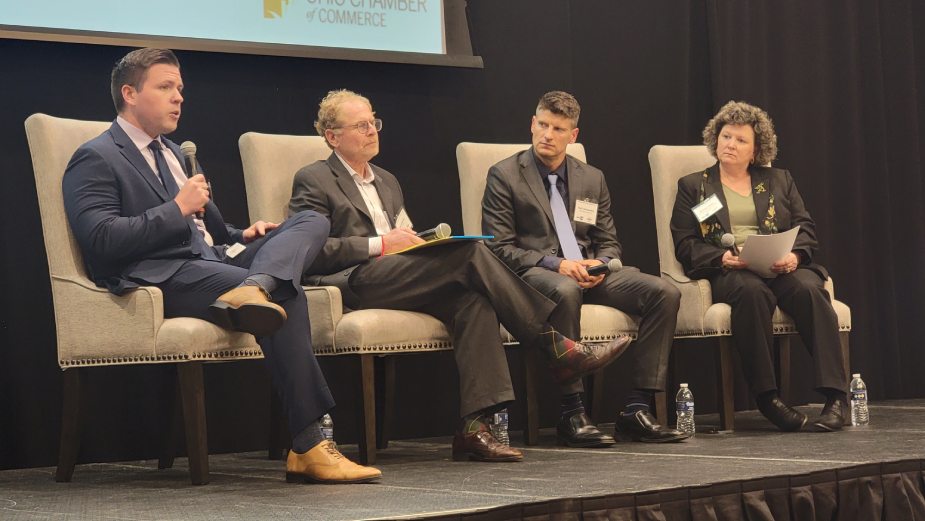Why Did 400,000+ Quit Jobs in Region? It’s Complicated, Study Finds
CLEVELAND – As businesses seek to hire, retain their workforces or simply keep the doors open at their sites, many have been begun to ask, “Where are the workers?”
Recent statistics show there are two jobs for every person unemployed. Did everyone retire? Were too many unemployment benefits made available? Is everyone at home taking care of the children? Have people just decided they no longer want to work?
While there are many anecdotal answers, Bethia Burke, president of Fund for Our Economic Future, says her organization went looking for the real reasons here in northeastern Ohio. The fund joined forces with the Corporate University at Kent State University Stark, Team NEO, PolicyBridge, ConxusNEO and the Center for Marketing and Opinion Research to use surveys, roundtables and other ways to extract information from business leaders and workers in the 11-county area, which includes Trumbull and Mahoning counties.
“We did a team effort to get this broad set of information both from execution partners as well as funding partners,” Burke says.
What they found is published on the website WhereAreTheworkers.com.
Burke says there is not one explanation to the question, adding that people are complicated. One in three employees said they were laid off since the pandemic began, Burke says. Employers are struggling to find employees. Attitudes about work seem to have changed.
“It really felt like a point in time when companies were asking what they could do to be more competitive for talent and without asking workers, who would know,” Burke said.
She believes it is important for employers to talk to their employees if they want to get a good grasp on what employees want from their work lives and why they are leaving. While companies and employers have long asked what they are looking for in quality employees, Burke says, a less frequently asked question is what are employees looking for in an employer?
UNEXPECTED RESULTS
More than 125,000 employees in northeastern Ohio retired since the pandemic and Burke says she was surprised to see many of the people who retired are not who she initially thought they would be. She had believed the retirees were the well-to-do, people who have accumulated a large amount of money, left the stock market at the right time and feel they can afford a comfortable retirement. Instead, she says, results show they are more likely to be lower-income individuals with less stability.
The population is aging in northeastern Ohio. U.S. Census Bureau data from 2020 shows 24% of the population is ages 65 and older, while 35% is between 45 and 64. Both age groups are higher than the national statistics, which show 22% are 65 and older and 32% between 45 and 64.
In addition, Burke says, she was surprised by the quit rate, those who have lefts their jobs –- 408,313 in the past year – and the number who said they were still thinking about quitting in the next year.
One in five employees says he plans to quit his position and about 83.4% of those considering quitting would look to find another job, the study showed.
At the same time, about half of those considering quitting said there was also something their employers could do that would convince them to stay.
“So anyone who employs people should look around and say 20% of these humans that I employ are considering quitting,” Burke said. “I should ask them what it will take to make them stay.”
She believes so many employers fail to ask what their employees are not getting from work, which could include flexibility, security, a general feeling that an hourly worker is just as important as a salaried worker.
“There’s been a shift in the way people think about work in a significant and meaningful way,” Burke says, citing that 37% of the people surveyed believe work is less of a priority since the pandemic. That is different than what sentiments were just a few years ago, Burke says.
“Out of the Great Recession there was a hangover of a feeling of instability from people, who either entered a really difficult job market or were laid off and found it difficult to get back into work,” she says. “That led to a lot of people feeling that they couldn’t move around in their job.”
During the COVID-19 pandemic, Burke says, people not only faced instability, but also concerns for their own health and their family’s. That has pushed work-life choices in a different direction.
MORE THAN JUST WAGES
While wages remain the top consideration in taking a job and 72% of employees in the study stated it is important to see wages in the job listing, the study also emphasized there are other things employees seek in addition to money.
Over the past two years, more than 56% believe they are more stressed at work and 20.5% of workers have called off sick because of burnout. They want meaningful work, flexible hours, paid time off and an opportunity for advancement.
What about remote work? The survey shows 63% of northeastern Ohio employees want to have the ability to be fully, mostly or partially remote. But only 44% of the jobs here fall into those categories.
Instead of working full-time, more people are seeking flexible gig jobs, sometimes doing more than one to make ends meet or doing them in addition to a full-time job for extra money. Burke even sees people working those jobs, she says, with a child in tow in the back of their vehicles while making deliveries or in shopping carts while the parent is picking up items for a customer who uses an app like Instacart.
She is uncertain if that is a positive as it provides a parent with more flexibility or a bad thing as some have found the need to take their children along out of necessity.
One in five adults is doing some type of freelance or contract work with two-thirds of them doing it for two years or less. Yet Burke says the majority, 86%, say they enjoy this type of work.
The statistics show 15% of northeastern Ohio employees were part-time and the majority of those working part-time prefer being part-time. One in three full-time employees also dreams about being part-time. Those numbers may explain why business owners recently found it easier to fill part-time positions than full-time.
WORKFORCE CHALLENGES
The study showed the workforce is 5% more racially diverse in northeastern Ohio than it was just 20 years ago.
In addition, 45% of the households earn less than $50,000 per year and the rates of people with a college education in northeastern Ohio is lower than the national average. While 481,559 believe they need more training, many do not know where to find it, the study shows.
Besides education or training, some barriers to finding or maintaining a job can be more pronounced for low-income workers and people of color. Concerns include wages too low to support a family, health issues for themselves or a family member, a lack of experience, transportation problems, childcare issues and a lack of digital access.
Statistically, 556,911 people in northeastern Ohio remain without internet access and of those who are connected, 310,057 have only a smartphone without any other type of connected device.
Burke says sometimes keeping an employee can be as simple as learning what his challenges are and working with that person. It could be as simple as a bus schedule and a shift schedule not matching up.
But if a small adjustment can be made to help the employee make connections, it can make a huge difference.
Copyright 2024 The Business Journal, Youngstown, Ohio.



